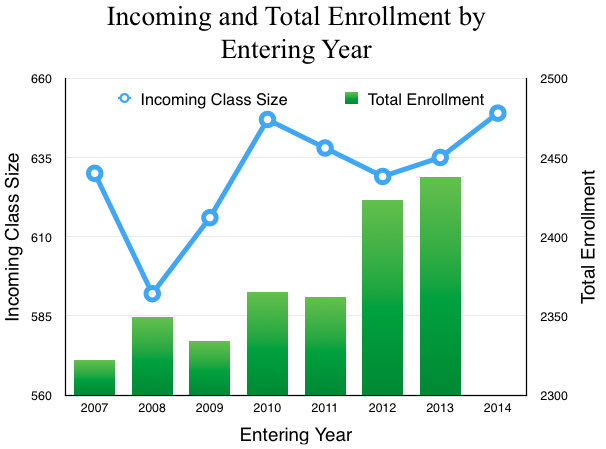Task force formed to discuss changes in size of the college
A recent assessment by faculty members of the size of Lafayette’s enrollment explored possibilities to adjust the amount of enrolled students and the scope of its programs.
The initial spark for the task force was the yearly increase in the incoming class size, according to Chairman of the Task Force on Enrollment Size and Program Capacity Jamila Bookwala. The average increase of incoming students rose on average by about 10 students every year since 2009, and the newest class is the largest in the college’s history.
President Allison Byerly formed the task force because she saw the concern the increasing class sizes caused in the minds of some faculty members.
“Even in the spring before I arrived,” Byerly said, “I knew that there had been substantial conversation on the floor of the faculty about a tendency of enrollment to creep up…every year.”
“What we were recommending to the president and her staff was that…if we’re going to increase in size, we want that to be strategic and well thought-out,” Bookwala said, “not the sort of gut reaction to the present needs that are budget-related.”
Growth in incoming class sizes creates pressures on faculty, especially in 100-level courses, according to Bookwala.
“There were some faculty members who thought that it was putting a lot of pressure on the introductory level courses,” Bookwala said. “[The question] was really, ‘where do we want to be? In 10 years, where should Lafayette be?
“Could we be bigger and do better, or be smaller and do better?” she continued.
The task force explained in the report that any change in the size of the college must involve enrollment size and faculty size. It also considered broader areas of change, such as expanded facilities and the amount of programs offered by the college.
“We always try to look at the picture as a whole,” Rinehart said. “For example, with the global studies building opening, will we want to offer more foreign languages?”
In addition to the Oechsle Center for Global Studies, the college is developing the Williams Arts Campus. With a recent donation from Kent Rockwell ‘66, the college also intends to expand interdisciplinary science facilities.
The Office of the Registrar estimated in the report that 100 to 150 more students could be accommodated in classroom space. This number assumes more use could be made of potential class times in the early morning and evening and is less than the report’s discussed 200-400 range increase in enrollment.
Members of the task force also considered the results from an open forum earlier this calendar year in which students expressed concerns outside academic building capacities.
“Students [at the forum] brought up parking,” Bookwala said. “Students brought up dining services. Students were concerned it would change the residential life on campus.”
Task force investigations into the use of Bailey Health Center, Skillman Library, and academic support programs indicated in the report that they were near, at, or above capacity.
“From a facilities standpoint, we are at capacity with some minor exceptions,” Vice President of Enrollment Management and member of the task force Greg MacDonald said.
Bookwala indicated that enrollment changes are often due to budgetary constraints, although she and members of her task force did not believe the budget played a large role in enrollment decisions.
“The budget is girding the discussion but it shouldn’t define the discussion,” Bookwala said.
“I wouldn’t say [the budget] is largely related,” MacDonald said. “It’s more [about] what fits right pedagogically and what fits right in terms of the community that we’re trying to build.”
The report nonetheless explores “viable sources of additional revenue” through calendar changes.
“Rather than trying to meet budgetary shortfalls by increasing the size of the incoming class each year,” the report reads, “the Task Force recommends that Lafayette take steps to enhance use of its program capacity during the winter interim and summer session(s).”
“You wouldn’t need that additional five or ten [students] if there was another way in which to generate that income,” Bookwala said. “If we use that premise, it would generate some revenue that would then be used to really enhance our own institution.”
The report intended to examine the size of the college and possible changes without specifying courses of action.
“There’s no definitive recommendation to grow the college based on the task for report,” MacDonald said. “I think some decisions need to be made about program capacity before we decide if we’re going to change enrollment or not.”
“I think this is now something that the president will lead,” Bookwala said. She explained that the major consensus was that incoming class size should be determined strategically instead of in a haphazard way.
Although the report provided an evaluation of the possibility of decreasing the size of the college, there is little discussion of it, according to Bookwala, who emphasized the potential loss in jobs and lack of use of major facilities.


























































































































Wlliam Rappolt • Sep 12, 2014 at 8:30 am
I applaud the administration for making well considered steps in regard to enrollment size. Ten years ago we received the Dehne report which pointed out the ideal spot for colleges is the 3-5k range. Given our desire to have a broad offering of courses across multiple disciplines we should be closer to average size of our peers. ( Lehigh,Colgate, Holy Cross, Bucknell, William and Mary ).
According to studies of the market place, only 5% of graduating high school seniors are attracted to small schools. Our unique posture as an engineering and liberal arts school would only be enhanced by carefully increasing enrollment. To my mind this is the central strategic issue for Lafayette, everything else is tactics on how to get there (faculty size, programming, facilities, and other peripheral issues). By making ourselves more attractive in the marketplace we can only enhance the quality of our applicant pool.